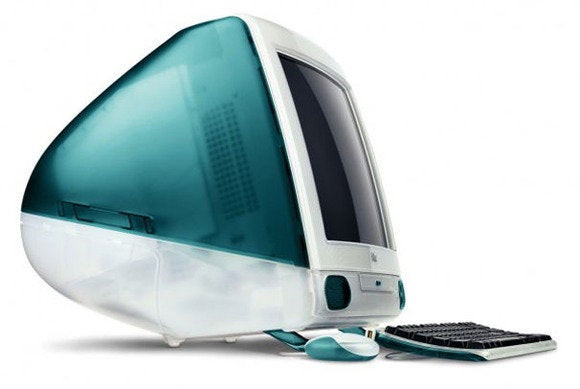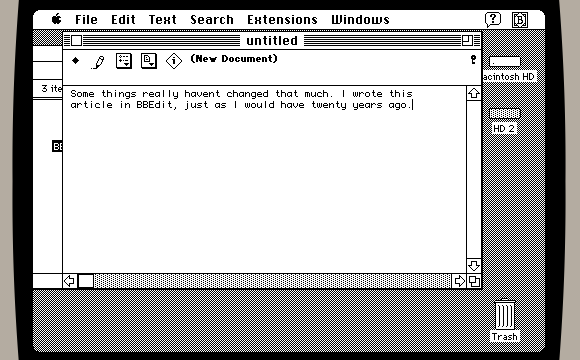For 30 years now, we’ve lived with the Mac, through the good, the bad, and even the ugly. But as we celebrate this momentous anniversary, I found myself wondering just how much longer the Mac we know and love will continue to be an integral part of our lives.
Apple’s executives firmly maintain that the Mac still has its own place in Apple’s grand scheme of things and that, despite the popularity of the iPad and iPhone, that place is secure.
Not to be a doomsayer, but looking back over how far the Mac has come in the last 30 years, I’m not sure if it’s future is as quite so assured. If we look ahead another 30 years, will the Mac still have a place then?
The Mac that was
It used to be that the Mac was all there was.
When the Macintosh—yes, some of us remember when it was a three-syllable name—first arrived on the scene, it turned the entire idea of computers on its head. Instead of an arcane command line that required mastery of special keywords and Byzantine syntax to accomplish even the simplest of tasks, users were greeted by a friendly desktop, with recognizable icons that made it easy for regular people to use a computer.
It was, undeniably, a revolution.
Throughout the 1980s and 1990s, Apple’s future was tied to the success of the Macintosh. When the Mac’s fortunes dipped, as they did under the onslaught of Windows PCs, consumers worried about the ultimate fate of the company. And the device that ushered in Apple’s late-90s renaissance was a computer: the original iMac.
But increasingly, despite its recent record-setting sales, the Mac has taken a backseat to Apple’s newer products: first the iPod, then the iPhone, and now the iPad. With these other product lines contributing so much of Apple’s overall revenue and sales, it sometimes seems as though the old Macintosh is to Apple what bicycles eventually became to Land Rover: a once-profitable sideline business that has now reached technological and market maturity. Even revolutionary products and inventions have their peaks and valleys.
Just a few years after their respective introductions, the iPhone and the iPad are more prominent and popular than the Macintosh was even in its heyday. There are plenty of reasons why: Even now, iPads and iPhones are cheaper than most Macs. More significantly, our society has evolved to a point where computing has become ubiquitous; it no longer requires a traditional computer per se.
Computers are no longer something you keep on your desk at work or at home; they’re with you all the time. Just as laptops supplanted desktops for many users in the late ’90s and early 2000s, smartphones and tablets have already begun to replace laptops for many everyday computing tasks.
The Mac that will be
By now, we’ve all heard Steve Jobs’s famous soundbite comparing computers to trucks and smartphones and tablets to cars. It’s not simply a case of one technology replacing another just because it’s better. Nor is it a matter of two complementary technologies coexisting; the microwave still hasn’t replaced the stove for most people. Rather, the question has become whether a technology isgood enough for most people. Smartphones and tablets are doing to traditional computers what cell phones did to landlines—not completely ushering them out of existence, but reducing them to more specialized tools reserved for those who really need them.
The Mac has already started down its road of being a niche product. While Apple appears prepared to continue catering to those niches, consider the new Mac Pro—a machine that even power users acknowledge may be too much.
Despite all that, I don’t expect to go Mac-free anytime soon. As a writer, I’m still in a niche market: The iPad and iPhone can handle a lot of what I need to do, but they can’t quite match up to the sheer convenience and customizability of my MacBook Air. But then again, I’m a technically savvy user whose Mac tweaks once prompted raised eyebrows from a couple of Apple Geniuses. My aunt and uncle, on the other hand, just need to read email and look at webpages; they’re only too happy to ditch a seven-year-old PC laptop to go iPad-only. And we know they’re hardly alone.
That shouldn’t be a surprise: The trend in personal computing is toward simplicity and prevalence, two concepts that often go hand-in-hand. Most people don’t want to change their own oil or replace their own timing belt; they just want a car that is going to get them from point A to point B and not break down. The same is true with computers, no matter what form they take.
Long live the Mac
This isn’t a death knell, by any means. I believe the Mac will persist for a good while longer, both for Mac enthusiasts and for those whose jobs require specific capabilities—serious video-editing, for example, or the ability to develop the very apps that run on our Macs and iOS devices. Eight-tracks and cassette tapes might have died out, but vinyl records still have a vibrant and passionate fan base. But as in that arena, we enthusiastic power users have never been the biggest, or—despite what we might like to think—most influential chunk of consumers.
And, really, the Mac has already survived against long odds, given its survival over the last 30 years. Sure, it has adapted, changing operating systems, changing hardware platforms (twice), and going through countless models. But at the most basic level, the Macintosh of 1984 is surprisingly recognizable in the Mac of today. In a field where progress often seems to happen with whiplash-inducing speed, that’s no small thing: Among the many items that can be replaced by a smartphone, the Mac is perhaps the hardest to leave by the wayside. And it’s hard to imagine many of the other devices that have come along in recent times—MP3 players, portable DVD players, fitness trackers—lasting a single decade, let alone three.
So what’s left but to look forward? Ten years from now, will we still be using Macs? I think so. But 20 or 30? I’m not so sure; I think we’re closer to the end of the Mac’s life than we are to the beginning—especially considering Apple’s propensity for innovating. Despite Apple’s own insistence that the Mac will go on forever, the way we interact with technology is changing rapidly; all good things, as the saying goes, must eventually come to an end.
For now, though, Apple’s success of recent years shows no signs of abating, and that means the Mac will be with us until it’s no longer profitable. We’re a long way from the doldrums of the 1990s, and despite any worry that the Mac has found itself overshadowed by its smaller, sleeker cousins, the rising tide of the iPad and iPhone have lifted the Mac’s boat, too.
So don’t consign your Mac to the dustbin of history just yet—like a certain hunk of junk, it may not look like much, it’s got it where it counts.



 PHOTO: MICHAEL HOMNICK
PHOTO: MICHAEL HOMNICK
